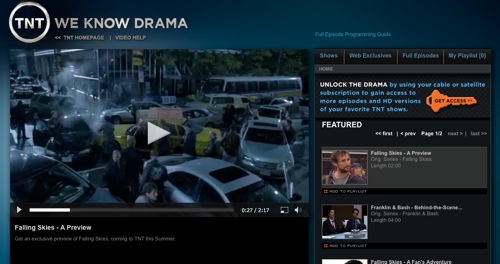-
Adobe Pass Boosts Cable Networks' TV Everywhere Role
Adobe is announcing a new service this morning called Adobe Pass, which is intended to streamline how pay-TV subscribers gain access to authenticated premium content online. While Adobe Pass offers a key benefit to users in the ability to have "single sign-on" across multiple devices and web sites, a more critical upside is that with Adobe Pass, cable networks gain far greater control over their relationships with viewers as TV Everywhere efforts ramp up. In this respect Adobe Pass is a potentially significant building block in helping make TV Everywhere a reality. Todd Greenbaum, senior product manager at Adobe, briefed me earlier this week.
First, from a technical perspective, Adobe Pass looks like a pretty elegant solution that positions it well to be the glue that hold TV Everywhere authentication together. The idea is that when a user visits a content provider's web site they'll still see freely available content, but they'll now also see some that is for paying subscribers only (see TNT example below). If the site has added the Adobe Pass software, then when the user clicks on the authenticated content, a selection of pay-TV operators who have integrated the Adobe Pass API will appear (currently Comcast, Cox, DISH and Verizon are all on board). The user selects their pay-TV provider and is then asked for the user name and password they use with their pay-TV operator.
In the background Adobe Pass makes an API call to the relevant provider to receive an authentication token, whose expiration policy is customizable. If the content site is using Flash as their run-time, then the token is held securely in the Flash client, with a unique device ID. If the user subsequently accesses other content on the site, or at other sites, authentication happens seamlessly without further credentials being requested. Where Flash isn't the run-time, browser cookies are used which essentially serve the same purpose, albeit with less security, without the device detection and not cross-browser. DRM choices are also flexible. Also being announced today is that Brightcove and Limelight are integrating Adobe Pass, so their content publishers get seamless access.
All of this is good news for users, who of course just want to get to their content with the minimum number of hurdles. But as mentioned above, the real upside to Adobe Pass is that it helps realize one of the original goals of TV Everywhere, which is that full-length programs could be equally as available on the cable networks' own sites and apps, as well as on other connected devices. That means it wouldn't just be pay-TV operators' portals only, as it is currently.
As the Internet has gone mainstream, cable TV networks, long accustomed to being in a wholesale supplier mode to pay-TV distributors, have steadily built up their direct customer relationships and brands through extensive online initiatives, including lots of video clips. Enabling full program viewing on their sites (akin to what Hulu offers) would be very significant for them, as it would unlock program access from the set-top box, providing improved user experiences and loyalty.
In the ongoing balance of power struggle with pay-TV operators over TV Everywhere (witness the cease and desist letters Time Warner Cable is getting in response to its iPad app), cable networks' ability to promote to their viewers that full-length shows are now also available, could help defuse some of the tension by giving cable networks a little more comfort. Pay-TV operators will still also want the rights to stream these shows, but the fact that the cable networks can assert greater control and gain promotional flexibility (e.g. sneak previews for certain users, etc.) will certainly increase TV Everywhere's appeal.
Adobe Pass isn't a silver bullet, but it's a meaningful step forward for TV Everywhere.
What do you think? Post a comment now (no sign-in required).
Categories: Cable Networks, Cable TV Operators, Technology
Topics: Adobe, Time Warner Cable


